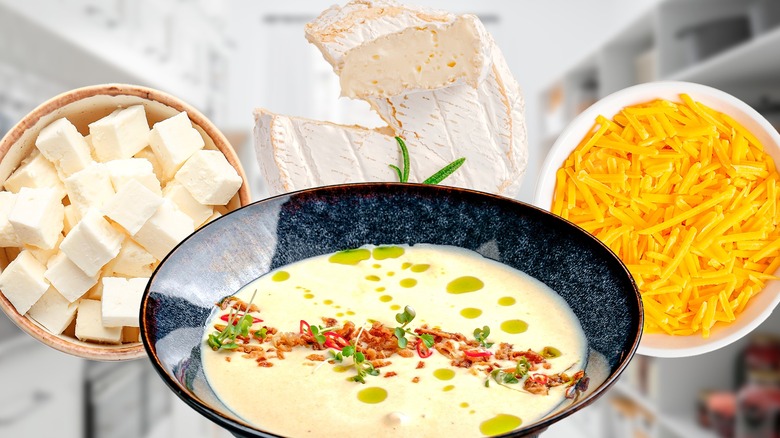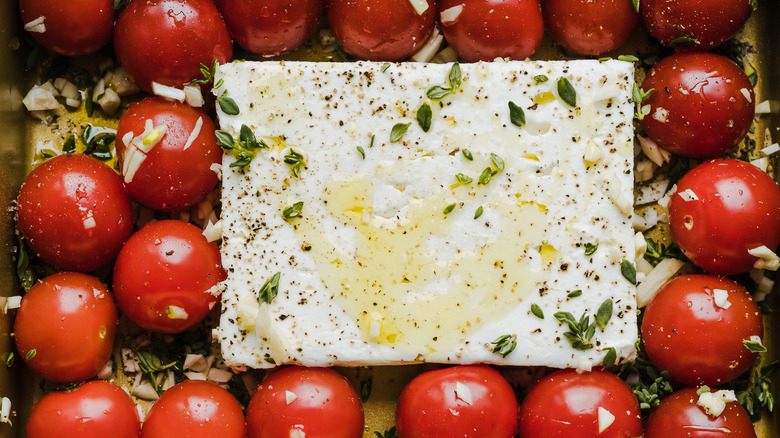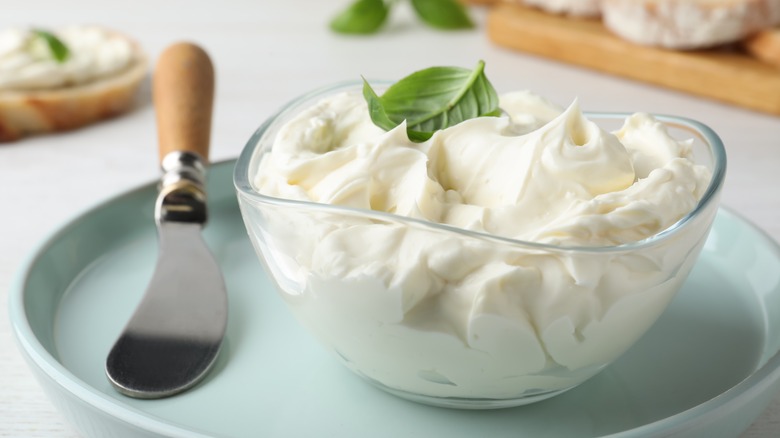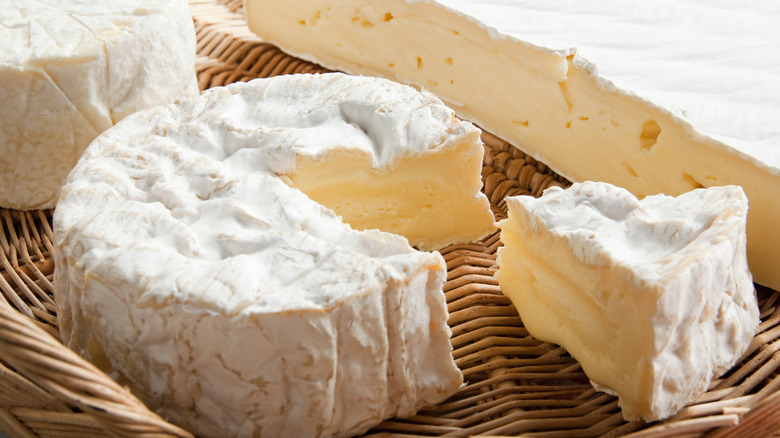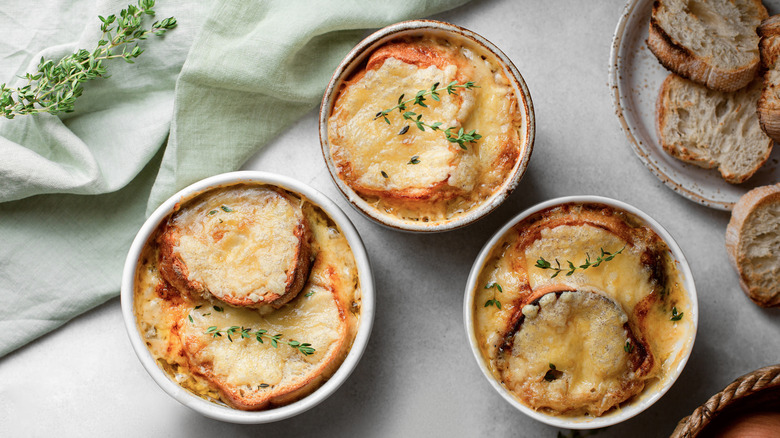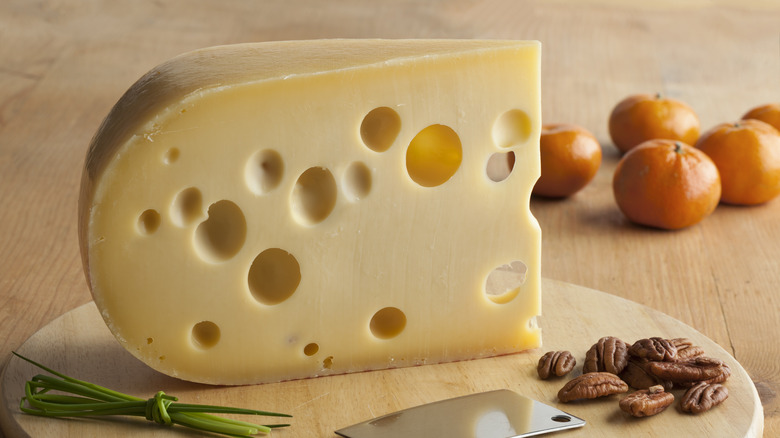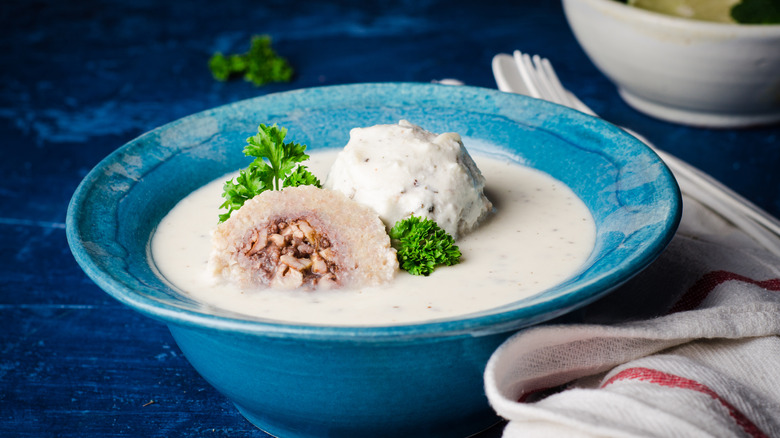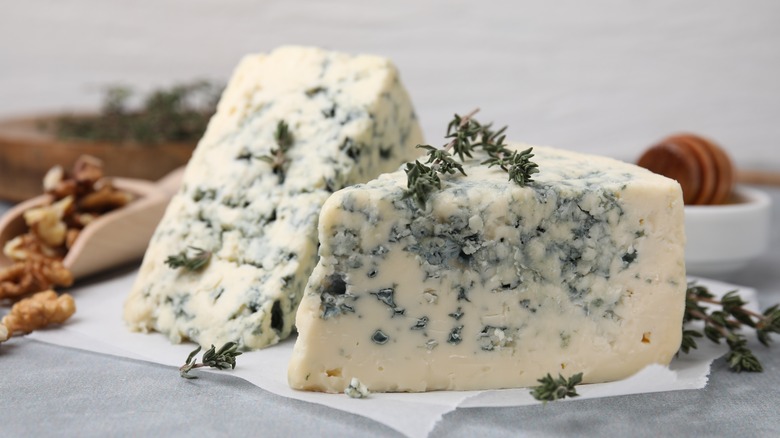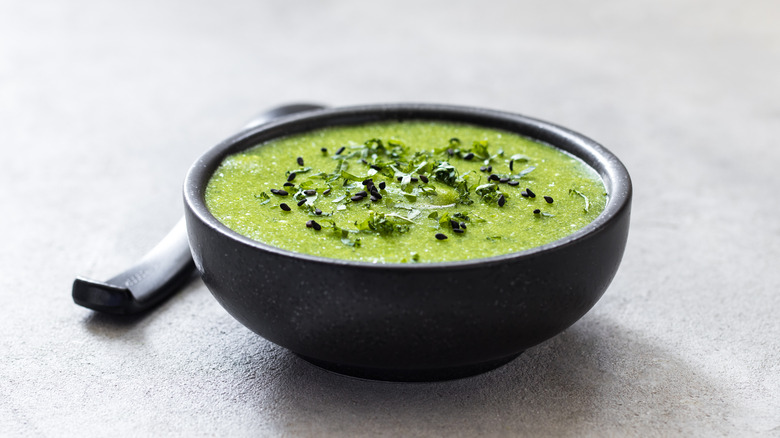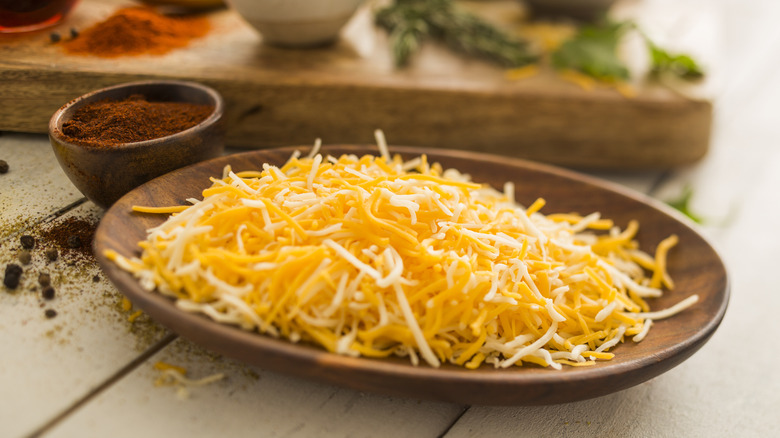The 9 Absolute Best Cheeses To Use For Creamy Cheese Soup
Creamy, cheesy soup is a beloved comfort food that combines a warm, satisfying soup with rich and flavorful cheese. Cheese is a popular ingredient around the world that can enhance soup in a number of ways. It adds protein and a depth of flavor that can range from nutty to salty to tangy. It comes in countless varieties, so you can include your favorites or choose cheese and soup ingredients that will complement and balance each other. Most of all, cheese can transform soup into a luxurious dish with a thick texture that can range from slightly chunky to silky smooth.
Whether it's a classic broccoli and cheddar soup, a hearty French onion soup, a unique Brie and leek soup, or even a cold cucumber soup served in the summertime, there's a cheese out there that will really make the dish. It can be confusing to know which cheeses to pick and how to use them properly, so we reached out to an expert to help clarify what some of the best choices are and why. Rebecca Weimann, who hails from Bern, Switzerland, is the head cheesemaker for Atwater's in Baltimore, a restaurant that connects local farmers to the surrounding community and makes all of its products, including bread, soup, pastries, and, of course, cheese, from scratch. Read on to discover which cheeses can enrich and enhance your soup, how to make the classics, and discover some new pairing ideas to add to your soup repertoire.
Feta
Feta is a salty and tangy Greek cheese traditionally made with sheep's or goat's milk but often made today with cow's milk. This white-colored cheese is sold in the brine in which it's cured, which also helps preserve it for months. In the United States, feta is a popular addition to tomato soup.
Because it's highly acidic, feta doesn't melt like the other cheeses on this list. Even if you heat it, it won't melt into a puddle like Brie or form strings like mozzarella. While it won't lose its general shape, it will noticeably soften. This gives you options when adding feta to soup. The easiest way is to just crumble it into the soup pot and let it simmer. It will add richness, a salty flavor, and textured creamy mouthfuls of cheese. You can even bake the feta first, just like you would do when making this baked tomato feta pasta recipe. Then just add the baked cheese and tomato mixture to vegetable broth instead of serving it with pasta.
For the creamiest result, blend the feta first. Rebecca Weimann recommends blending it with tomatoes to create a creamy tomato soup that will be much smoother than one made with crumbled feta. For the smoothest result, stir crumbled feta and whole milk in a double boiler until it's thick and creamy before using it in soup. Besides tomato soup, feta is delicious in other vegetable-based soups featuring broccoli, spinach, beets and carrots, or red peppers.
Cheddar
Cheddar is a main player in soups ranging from a traditional broccoli cheddar soup to a thick and creamy cauliflower cheddar soup and a complex beer and cheddar soup. This versatile cheese is available at different stages of maturity (longer aging equals more flavor), and with a high moisture and fat content, cheddar helps create a rich, creamy, and smooth result — everything you want a cheese soup to be.
Rebecca Weimann acknowledges that cheddar is a staple in the United States. "A lot of people like the flavor, and it also melts well," she says. She credits its popularity to the versatility afforded by the aging process. For example, young cheddar aged three months melts well without having an overly stringy texture, while the flavor of cheddar aged two years is much more pronounced. You wouldn't have to put as much in the soup to enjoy the deeper flavor.
Potato leek soup is a fantastic canvas for cheddar, Weimann says, while for a heartier option, she thinks "a beer soup would be really good because cheddar has a strong flavor, and it can stand up to beer." A thick bread soup would likewise be appropriate. Using an aged cheddar for hearty soups is a good idea because, as she explains, "the more aged the cheeses are, the less moisture they have and the more they break down," making them less stringy, which means the texture as well as the flavor would be ideal.
Cream cheese
Some recipes call for cream cheese because its mild flavor can add a serious dose of creaminess to soup without adding much to the taste, and that's sometimes a good thing, especially for soups that already have strongly flavored ingredients. One example is creamy taco soup. The divine meltability of cream cheese creates a silky-smooth texture, allowing the other ingredients to shine. And in this case, its mild taste doesn't interfere with the flavor game that ingredients like cilantro, lime, chili powder, and dried spices bring to the soup.
Rebecca Weimann weighs in: "I think cream cheese is good to a certain extent. I mean, if what you want is creaminess, then cream cheese is definitely a great option." However, she points out that "it doesn't have that much flavor. And if you put [in too] much cream cheese, then your soup can just taste like cream cheese." She warns that using too much will also make soup heavy because it contains high levels of milk fat.
Given these considerations, Weimann suggests cream cheese could work best in a cold soup in the summertime, especially if the soup is tomato based. Cream cheese doesn't need to be heated to be blended easily, which is another reason that it's good for cold soup, Weimann explains. Her other recommendation is just adding a small amount of cream cheese for a creamy texture and combining it with a different, stronger cheese for flavor.
Brie
Brie, named after the historic region in northern France where it originated, is a soft-ripened cheese made from cow's milk. It is very popular in France, where cheese is served as a separate course right before dessert. While the most prestigious forms, unpasteurized Brie de Meaux and Brie de Melun, are made on French farms, imitations are made today in countries throughout the world.
For Rebecca Weimann, Brie was at first a surprising choice for soup, but she quickly came to appreciate it. She recounts: "I once had a Brie leek soup, and it was phenomenal. First I thought it felt so weird, for somebody here at work had made it because we had leftover Brie, and it was one of the best soups I've ever had. It's really good."
This praise is not unusual for Brie, a highly prized cheese once offered as tribute to kings in France. Weimann says Brie's pleasing aroma is a clue to why it's so good, explaining that cheeses that smell the best are really high in fat. As many studies over the years have shown, fatty foods taste really good. She includes Camembert in this category and adds that cheeses of this type also melt really well, making them good choices for soup. As an added bonus, both Brie and Camembert are considered safe choices for people who are lactose intolerant. Both cheeses have a lactose level of between 0 and 2%.
Gruyère
Gruyère is a firm cheese made from cow's milk and is named after the region of La Gruyère in western Switzerland, one of the places where it's made. It's aged from three to six months and develops a strong and nutty flavor.
Rebecca Weimann says the secret of its delicious, rich flavor comes from the cows in Switzerland. She explains: "Gruyère is made with milk from cows that graze on pasture, and the cows have to go outside every day, even in the winter, even if the cows are not really pumped to go outside because it's so cold ... And so in the summer when they graze or else in the spring when they graze on the grasses and the flowers, the milk just turns into this really, really rich, flavorful milk. And then that translates into a phenomenal cheese. I mean, the better your milk, the more flavorful your milk, the better your cheese is gonna be."
Gruyère is a wonderful cheese for melting, which is why it's popular in fondue, soup, and cordon bleu. In the United States it's best known in French onion soup. "I can imagine that Gruyère would be tasty in a mushroom soup," Weimann adds, "because mushrooms have a really nice, earthy flavor and Gruyère has such a wide flavor profile that I think it could complement it really well." Don't stop at soup, though. Weimann says its meltability makes it delicious melted on bread.
Emmental
Rebecca Weimann, an artisan cheesemaker from Switzerland, isn't a big fan of what's called Swiss cheese in the United States. "I think what people are trying to do is make Emmental, which is the flavor of Swiss cheese here in the States," she says. She explains that Emmental has a nutty flavor and big holes, two qualities that American Swiss cheese tries to imitate. The cheese, also known as Emmentaler or Emmenthaler, gets its name from the Emme River valley in Switzerland where it was first produced.
Although nothing would beat tasting this cheese in Switzerland, it can luckily be found in the United States. You may need to seek out a specialty supermarket to find higher quality pieces, and that does come with a price tag. Splurge if it's worth it to you because the price indicates some notable differences between American and European cheeses. While this isn't always the case, American cheeses are often produced through industrial processes and include more processed ingredients, while European cheeses tend to be made with natural ingredients using traditional artisanal methods tied to local geographic areas.
Try substituting Emmental in recipes that call for Swiss, or seek out soup recipes that specifically call for the original. You could create an Emmental cheese soup by first making a roux with butter and flour, adding wine and stock and then cream, and then stirring in Emmental and seasoning the soup.
Labneh
For a Middle Eastern twist, consider labneh as a tasty and unique cheese to use in soup. This ancient cultured dairy product is known to have existed for over 2,000 years, originating in the Levant region, an area in the Middle East also known as the Fertile Crescent. We say cheese, but labneh has qualities of both yogurt and cheese. In fact, it's sometimes referred to as a yogurt cheese. Labneh has a thick, creamy, and spreadable consistency reminiscent of cream cheese and a tangy, salty flavor that pairs well with savory dishes. You can even make your own labneh at home with only two ingredients: plain full-fat (non-Greek) yogurt and salt.
Since labneh is a very soft cheese, similar to Greek yogurt, Rebecca Weimann recommends using it in cold soups. She explains that there's a high risk of such a loose cheese and fermented product curdling when added to hot soup, especially if the soup is acidic, like a tomato soup, for example.
She thinks labneh would be tasty in a gazpacho, a cucumber soup, or similar cold soups. A cold cucumber soup, for example, has a base of cucumbers flavored with cilantro, mint, and lime juice. "Adding some labneh on top of that could balance out that freshness and just get the soup a little bit more body," she says. Just adding a little lime juice, especially when the soup is cold, keeps the cheese from curdling.
Blue cheese
Blue cheese is not just one kind of cheese but a group of cheeses named for the notable bluish or greenish spots scattered throughout an otherwise pale interior. Mold spores are added to the milk to produce those characteristic mold veins that contribute to the cheese's strong flavor and aroma. Well-known types of blue cheese include Italian Gorgonzola, French Roquefort, and English Stilton. No matter the name, all blue cheese is made with the same mold, Penicillium roqueforti, although it may be referred to by the name of the specific subspecies used in a particular cheese.
The texture of blue cheese can range from crumbly to very soft and spreadable. Rebecca Weimann considers it suitable for soup because it melts very well in general, especially the creamy blue cheeses like Gorgonzola or Roquefort.
People tend to have strong opinions about blue cheese, either loving it or hating it. For those who seriously dislike it, there's not much that can convince them to get past its strong and, to them, quite unpleasant smell and taste. But for blue cheese lovers, soup is another way to enjoy this distinctive ingredient. Weimann recommends combining blue cheese with potatoes, leeks, asparagus, broccoli, ham, onions, or bacon for a really great overall flavor. This could mean a creamy potato broccoli soup with garlic and cream, a buttery potato onion soup with chives, or a cauliflower blue cheese soup full of vegetables and topped with crispy bacon.
Cottage cheese
Cottage cheese is a bright white, thickly textured, unripened cheese made from skim or low-fat milk. The milk forms curds, which can be small or large depending on the variety, and they sit in a small quantity of liquid whey, which is not completely removed during the cheesemaking process. Cottage cheese has a mild flavor and is much lower in fat than many other cheeses. For example, a half-cup serving of low-fat cottage cheese made with 1% milk has only 1 gram of fat, while a 1-ounce serving of cheddar has 10 grams of fat.
This makes cottage cheese a good choice for soups with a lower fat content, since cheese is a notoriously high-fat food, while keeping the dish creamy and full of protein. Cottage cheese doesn't melt completely, so don't expect the glass-smooth result of melted cheddar. However, it will soften and partially melt enough to make a creamy soup.
Rebecca Weimann thinks cottage cheese would be great in spinach soup, and she recommends blending the curds first. "The curds could be blended with or without the spinach. It just depends on whether you want a coarser texture or a fine one," she says. "That would also be a high-protein and relatively low-fat soup, so it's definitely a great alternative to a heavy cheddar soup."
Don't use these cheeses in creamy cheese soup
While some cheeses are phenomenal in cheese soup, others don't perform so well. For example, some people like to stir grated Parmesan into soup to add a rich, salty flavor, but it doesn't melt very well. The soup will remain gritty. Rebecca Weimann prefers reserving Parmesan as a topping. She explains that since it's made with skim milk, there's not a lot of fat to make soup creamy, and its intense flavor is best appreciated when the cheese is grated over individual bowls.
There are a few cheeses Weimann doesn't recommend because they get stringy, which messes up the soup's mouthfeel and makes it hard to eat. Mozzarella in particular is made by stretching curds, which produces a stringiness that's great on pizza but not so great in soup. She adds that the mild taste of mozzarella doesn't benefit the soup's overall flavor either.
Gouda and Fontina may melt pretty well when a soup is piping hot, but once it cools down enough to eat, the cheese will start to solidify and get stringy, Weimann explains. Using just a little could work texture-wise, but if you use enough to appreciate the flavor, it will turn stringy. Finally, Weimann doesn't use Monterey Jack in soup because, like mozzarella, it has too bland a flavor. She says that once you add enough to make the mild flavor evident, the soup becomes too heavy, more like a cheese sauce than a soup.
How to achieve the ultimate texture and meltability in cheese soup
Keep a few points in mind before adding cheese to soup in order to achieve an even, creamy texture without unwanted lumps, unmelted cheese, or broken down cheese that dries out. First, keep a close eye on the heat when melting cheese in soup. Turn the heat down to a low simmer at first because you want to allow the cheese to melt slowly and evenly, melding with the other flavors in the soup at the same time. If you add cheese when the liquid is boiling, it will lose moisture and clump up. Wait until the last 15-20 minutes at the most before adding cheese so it doesn't stay on the heat for too long. Don't throw it all in at once either, but stir or whisk it in a handful at a time, waiting for the cheese to melt before adding more.
For the best melting, prep the cheese properly. Unless you want a chunky texture, first blend cheeses like feta or cottage cheese that don't fully melt. Bring cream cheese up to room temperature and blend it, or microwave it for 15 seconds at a time until it's very soft before gradually whisking it into the pot. Firmer cheeses like cheddar and Emmental should be shredded first with a box grater or chopped finely for an even melt. This is better than buying pre-shredded cheese, which contains anti-clumping agents that hinder melting.
